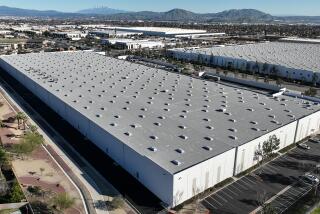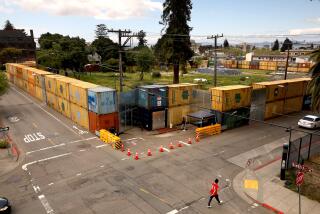AQMD Rejects Key Smog Proposals in Blow to Businesses : Environment: Governing board votes 8 to 3 against nine controversial measures that would have reduced industry’s anti-pollution costs in South Coast Air Basin.
In a dramatic setback for business, the South Coast Air Quality Management District on Friday soundly rejected a series of controversial proposals to reduce the costs to business of fighting smog.
By an 8-3 vote, the AQMD governing board defeated nine measures--including those that would have exempted most first-time pollution offenders from paying fines, reduced requirements on employers to encourage workers to share rides or take public transit, and roll back goals for increasing the number of riders per vehicle to reduce smog and congestion.
The board also rejected a requirement that would have amounted to a “devil’s advocate” analysis of new anti-smog rules proposed by the AQMD staff as well as a proposal to create an independent ombudsman to plead the cause of business before the district.
The defeat of the ombudsman proposal was a personal victory for AQMD Executive Officer James M. Lents, who last month said the board could fire him if it felt an outside advocate for business was needed.
The nine rejected proposals were part of a series of 44 recommendations made last month by a special commission appointed by the AQMD after complaints mounted that business was paying too heavy a price in the war against smog. The other 35 recommendations--ranging from improving service to small businesses to upgrading public education efforts--were formally approved by the board Friday. Most have been implemented by the AQMD.
Immediately after the vote to reject the nine key proposals, one businessman vowed to mount a grass-roots campaign to oust AQMD board members who had voted against the pro-business proposals.
“I think the board, particularly the members who opposed what was a reasonable request by the business community . . . should consider there will be political repercussions,” said Cody G. Cluff, director of business retention for the Economic Development Corp.
Friday’s vote came after months of lobbying by business interests to cut the cost of air pollution controls in the four-county South Coast Air Basin.
The outcome of the daylong public hearing clearly stunned the business community, which had counted on adoption of the key recommendations. Only hours before the vote, they were hailing it as a “defining moment” in the often rocky relations between smog regulators and business.
As the proposals were rejected, business officials turned to calling the vote “a crushing blow” to their hopes. Environmentalists, who had been skeptical about the recommendations, were applauding the AQMD for demonstrating its independence from business interests.
“Most of the onerous recommendations were stopped,” said Tim Little of the Coalition for Clean Air.
The recommendations, which would have shifted more of the smog-fighting burden from businesses to vehicle owners, created a storm of controversy last month when they were made public.
During Friday’s hearing, the controversy continued. Even before the session began, community activists and environmentalists marched outside the AQMD’s Diamond Bar headquarters, carrying placards declaring, “Big Business, We Smell Injustice” and “Be Fair With Clean Air.” Several demonstrators warned that deregulation would hit hardest against the poor who live in neighborhoods where many of the biggest industrial polluters are located.
Jim Jenal, clean air program director for Citizens for a Better Environment, complained that an ombudsman would become “an in-house lobbyist for the basin’s polluting industries.”
But throughout the session, representatives of business stood up to blame job losses and businesses leaving the state on costly air pollution controls.
Raymond E. Robinson, a spokesman for the Southern California Paint and Coatings Assn., complained that his industry had been hit with increasingly restrictive environmental regulations, “often without significant benefit to the environment.”
Others, AQMD board member and Los Angeles County Supervisor Mike Antonovich among them, said unemployment was 2% higher in California than the rest of the nation and cited the high cost of pollution regulations.
AQMD staff members countered that the region--Los Angeles, Orange, San Bernardino and Riverside counties--is no worse off than many other areas of the nation when it comes to the annual rate of economic decline and, in fact, is faring better than such key industrial states as Illinois, New York, Massachusetts and Texas.
In terms of job losses, the construction, aerospace, finance, real estate, wholesale trade and retail industries are the most severely affected in the region, according to the AQMD staff. Combined, they had 39% of the basin’s jobs in 1990, but only 37% in 1992.
Instead of environmental regulations, the staff quoted one outside report that blamed the region’s economic woes on the national recession, cuts in defense spending, and California’s volatile construction cycle.
“There is no substantial evidence that government rules and regulations are a principal cause of California’s below-average current economic performance,” the staff report said.
At the height of the debate, Los Angeles City Councilman Marvin Braude, an AQMD board member, said every smog rule adopted by the AQMD had been a “tortured process,” with full input from business.
Braude, who was among those who rejected the nine proposals, said the board had the “responsibility for protecting the health of the community. . . . What appears to be going on here . . . is a thrust to gut this institution to stop the effort to clean the air and to protect the public health.”
In addition to Braude, others voting against the proposals were Stephen Albright, Gov. Pete Wilson’s appointee to the board; Larry L. Berg, an appointee of Assembly Speaker Willie Brown; state Senate appointee Sabrina Schiller; Henry Morgan, representing Los Angeles County cities; Riverside County Supervisor Norton Younglove; AQMD board Chairman Henry Wedaa, representing Orange County cities, and Montclair Councilman Leonard Paulitz.
Those who voted for the nine proposals were Antonovich, Orange County Supervisor Harriett M. Wieder and San Bernardino County Supervisor John D. Mikels.
PERSISTENT SMOG: Smog is the lowest in years but it’s not always low enough. B3
Cutting the Cost of Fighting Smog
The following is a partial list of new steps approved by the South Coast Air Quality Management District to reduce the cost of air pollution regulations on business:
Step up independent research on the cost burden of air quality rules.
Push legislation to provide tax credits and other financial incentives for business to develop and implement innovative methods and technologies to comply with district requirements.
Improve outreach programs and other assistance to business.
Consult business earlier before new smog rules are developed.
Include an analysis of a proposed rule’s costs and impact on jobs and competitiveness.
Adopt the most cost-effective smog reduction rules first.
Provide a review of the effectiveness of new rules one year after they are adopted.
Reduce costly record-keeping requirements.
Back state legislative studies on shifting AQMD income sources from business to motor vehicles through higher vehicle registration fees or fees based on vehicle miles traveled or emission rates.
Take steps to see that fines fit the offense and not be used to intimidate the public into compliance.
Offer firms of all sizes the possibility of negotiating lower fines.
Expand small-business assistance program and make it more service-oriented.
Encourage environmental consultants and attorneys to provide free assistance or reduced fees for firms or individuals who cannot afford to pay for such help in dealing with the AQMD.
Step up AQMD efforts to educate the public about each individual’s responsibility for cleaning the air, particularly those who drive to work alone or fail to maintain smog controls on their vehicles.
More to Read
Inside the business of entertainment
The Wide Shot brings you news, analysis and insights on everything from streaming wars to production — and what it all means for the future.
You may occasionally receive promotional content from the Los Angeles Times.










